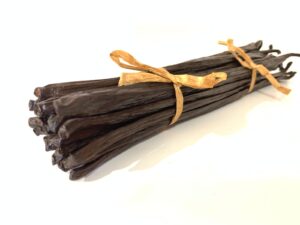What is the difference between Grade A and Grade B Vanilla Beans?
There are many mouth-watering recipes using Vanilla ingredients, however you discover that there are several species and furthermore, you have to make decisions between different grades of Vanilla Beans. All of a sudden, the excitements are fading.
What is the difference between Grade A vanilla beans and grade B vanilla beans? Aren’t grade A vanilla beans better? Should I use grade A or grade B vanilla beans in my DIY vanilla extract? You’d be right to be confused – it is a lot to take in and we are glad that you asked. Here we are going to break down the differences in all types of Vanilla beans – by grade, varieties and country of origin, so that you can shop wiser and use the vanilla beans to their fullest potential.

Grade A Vs Grade B
Vanilla beans grade range from grade A, Grade B, and Split. Let’s dive in a bit deeper into these difference grading. What does it all mean? There are 3 key differences between the different grades of Vanilla beans:
- Moisture level
- Size of the beans
- Curing Process
Grade A Vanilla beans also called gourmet or TK or Black or prime vanilla beans, they have higher moisture level (25-35%) compared to Vanilla grade B and are very dark brown/ black in color.
Grade A size minimum is 17cm up, why? it means that farmer/ curer didn’t use young vanilla beans. why? Young vanilla beans have less seeds and vanillin contents.
The process of making Grade A vanilla beans (curing process) are long which can take around 6 months and sometimes can be more.

Grade B Vanilla Beans

Grade B or extraction grade Vanilla beans can be more difficult to scrape the caviar because they are more dry and brittle. Moisture content is typically less than 20%. Grade B vanilla ideal for making extract because you can get more beans with the price of Grade A beans.
You can make extracts with Grade B Vanilla Beans, you can also make vanilla bean sugar and powder, not much more.
Grade A vanilla beans, on the other hand, can be used for all grade B vanilla bean uses, but also for anything that requires fresh vanilla bean caviar or fresh vanilla beans.
Top chefs usually prefer Grade A vanilla beans because they are great all-purpose bean and have higher moisture content allows the vanilla flavor to penetrate the dish quickly. Simply put, gourmet vanilla beans give off their flavor more readily than extract quality beans. So, whether you’re making a savory cream sauce, like this Parfait Vanilla Sauce, or a sweet treat, like creme brulee, Grade A beans will be your best choice for cooking and baking.
Vanilla Planifolia
Vanilla planifolia is a species of vanilla orchid. it is native to Mexico and now also grown in Madagascar, Indonesia, and Uganda. It’s the most common type of vanilla produced in the world, and though the taste and scent of these vanilla pods vary slightly by country of origin, you’d recognize the pungent aroma and flavor as unmistakably vanilla.
Madagascar Vanilla Beans are rich with flavor and aromatic qualities, it is rich dark, creamy, and with overwhelming sweet and buttery aroma. Indonesian Planifolia Vanilla Beans are sweet and creamy like their cousins from Madagascar, with a more complex flavor profile that finishes with unique earthy/woody undertones. They stand up well against stronger flavors like chocolate and caramel.
Vanilla Tahitian
Vanilla tahitensis (Tahitian vanilla), which is a cross-strain of Vanilla planifola (Mexican vanilla and Bourbon vanilla) and Vanilla odorata (Inflated Vanilla), is produced in French Polynesia, especially in Tahiti , and also Hawaii, but Papua New Guinea is one other nation that produces it. It’s the preferred vanilla when it comes to making fragrances, due to its high level of heliotropin, the chemical compound responsible for the floral scent. Pastry chefs also reach for this species, as its comparatively subtle flavor lends itself naturally to sweet bakes.
You may find more variety on the market. Whatever you choose, we hope you have fun experimenting with all the possibilities!
